Typhoon Connie
Contributor: David Stubblebine
ww2dbaseIn Dec 1944, elements of Admiral William Halsey's United States Third Fleet sailed into Typhoon Cobra where three warships and 790 lives were lost. After regrouping and one more very successful fleet sortie, Halsey faced a Court of Inquiry about the typhoon but no negligence was assigned. This was followed by a pre-scheduled four-month planning period away from the fleet before he returned 27 May 1945 as the fleet continued its assault on Okinawa. A mere ten days after Halsey's return, it happened again.
ww2dbaseHalsey's fleet was divided into several task forces and the task forces were further divided into several task groups. Although no one knew it yet, it was the 29-ship task group commanded by Rear Admiral J.J. "Jocko" Clark built around the carrier USS Hornet (Essex-class), along with an accompanying replenishment group of 47 ships, that were about to bear the brunt of this storm. Following Typhoon Cobra, Fleet Admiral Chester Nimitz made several changes to how the Navy's weather intelligence was gathered but the new system still had some bugs in it. During the first few days of Jun 1945, these weather stations issued several reports to Halsey and Clark alerting them to a storm approaching from the south. They sent, resent and duplicated the same information over and over again, all in code, so that the sheer volume of messages taxed Halsey's and Clark's staff. Once it was all unraveled, the information was largely repetitive, conflicting, outdated, inaccurate, or only marginally useful.
ww2dbaseOn 3 Jun 1945, amphibious command ship USS Ancon departed Okinawa bound for Leyte in the Philippines. Halsey instructed Ancon to provide weather reports directly back to the fleet as she transited south. Late in the day on 4 Jun 1945, Ancon's radar captured a clear image of a well-formed tropical storm on a rapid northeasterly track heading directly toward Clark's 76-ship formation. A message was prepared for transmission to the fleet, as Halsey had instructed, but since regulations required that all communications had to be coded, there was a delay before the message could be sent. Once Ancon's message was finally received by Halsey and Clark, the decoding at their end created another delay. Adding to the overall situation, a second storm was detected forming to the northwest that generated another flurry of coded messages from the weather stations. Relying on his staff's best estimates from the information they had, Halsey ordered course changes designed to steer Clark clear of the storm but, like in Cobra, they sailed directly into it. By the time Ancon's definitive report was fully comprehended by Halsey and Clark, the news was over five hours old and Clark's ships were already in it.
ww2dbaseThe storm that would later be named Typhoon Connie was a compact, tightly swirling, powerful tropical cyclone. Throughout the night of 4 Jun 1945, Clark's ships recorded increasing winds, plummeting barometers, and deteriorating seas. Just before daybreak on 5 Jun 1945, Hornet was recording steady winds at 100 knots with gusts up to 120 knots. The seas were described has having steady "mountainous pyramidal" parallel waves exceeding 60 feet from crest to trough. The escort carrier USS Attu reported riding over "the granddaddy of all waves." Both USS Hornet and USS Bennington had the leading 24 feet of their flight decks collapse over their bows in the rough seas. Heavy cruiser USS Pittsburgh had 110 feet of her bow completely break away. Twenty-nine other ships also sustained storm damage ranging from moderate to severe. At least 100 fleet aircraft were also damaged or destroyed. Thankfully and unlike Cobra, no ships were lost and only 7 men died.
ww2dbaseHalsey's experience with the Court of Inquiry after Typhoon Cobra led him to quickly and pre-emptively complain to Nimitz that weather estimates had conflicted and messages were garbled or hopelessly delayed by coding requirements. On 15 Jun 1945, Halsey and Clark, along with Carrier Task Force Commander Vice-Admiral John McCain and Replenishment Group Commander Rear Admiral Donald Beary, appeared before a Court of Inquiry aboard the battleship USS New Mexico in San Pedro Bay, Leyte Gulf, Philippines. The court was presided over by the same Vice-Admiral John Hoover who presided over the court inquiring into Typhoon Cobra. Blame was placed squarely on Halsey and McCain with the main cause described as Halsey's late-night course changes that brought Clark's ships directly into the storm's path, similar to what happened in Cobra.
ww2dbaseSecretary of the Navy James Forrestal was willing to retire Halsey but he and Fleet Admiral Ernest King decided it was in the Navy's larger best-interests to leave Halsey in command. McCain, on the other hand, was to be replaced by Vice-Admiral John Towers, but the actual transfer of that command did not take place until a few days after the Japanese surrendered. McCain's actual role in the typhoon was minimal but King harbored ill-feelings toward him, as did Nimitz, and removing McCain may have been a way of punishing Halsey without publicly humiliating the national hero.
ww2dbaseAs with Cobra, changes were made after Connie. Most notably, Nimitz' weather reporting stations had their communications systems streamlined and urgent weather reports would be issued directly to the fleet in plain English.
ww2dbaseTogether, Typhoon Cobra and Typhoon Connie would go down in history as "Halsey's Typhoons" and would be among the first things his detractors were quick to bring up. There were also lessons learned and many of the modern weather forecasting principles we know today have their direct roots in these two storms.
ww2dbaseSources:
Andrew Scott
United States Navy
Warfare History Network
United States National Oceanic and Atmospheric Administration
Japanese Meteorological Agency
Washington Post 16 Jul 2015
Wikipedia
Last Major Update: May 2021
Typhoon Connie Interactive Map
Photographs
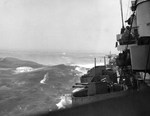 | 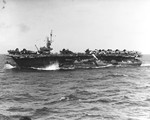 | 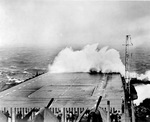 | 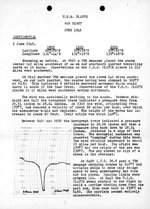 |
Maps
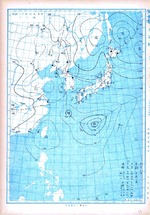 | 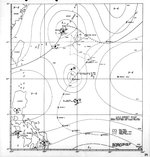 |
Videos
 |
Typhoon Connie Timeline
| 3 Jun 1945 | USS Ancon departed Okinawa, Japan for the Philippine Islands. |
| 4 Jun 1945 | Many ships from the United States Third Fleet, primarily Task Groups 38.1 and 30.8 sailed into Typhoon Connie south of Japan. No ships were lost but 7 men lost their lives. |
| 4 Jun 1945 | At 1848/I, USS Ancon's radar captured a clear image of a well-formed tropical storm on a rapid northeasterly track heading directly toward Rear Admiral J.J Clark's 76-ship formation of ships including carriers, battleships, and a replenishment group. Ancon prepared a message for Clark and Fleet Commander Admiral William Halsey but because of coding requirements and a heavy volume of similarly coded weather reports from other sources, Ancon's report was not fully appreciated by Clark or Halsey for over five hours. By then, Clark's ships had already sailed into Typhoon Connie. |
| 15 Jun 1945 | A United States Navy Court of Inquiry was convened aboard USS New Mexico in San Pedro Bay, Leyte to investigate what led 76 ships to sail into Typhoon Connie ten days before. Responsibility was placed squarely on Admiral William Halsey and Vice-Admiral John McCain, although no action was taken against Halsey. |
Did you enjoy this article or find this article helpful? If so, please consider supporting us on Patreon. Even $1 per month will go a long way! Thank you. Share this article with your friends: Stay updated with WW2DB: |
» J. J. Clark
» Halsey, William
» King, Ernest
» McCain, John
Ship Participants:
» Alabama
» Ancon
» Baltimore
» Belleau Wood
» Bennington
» Detroit
» Hornet (Essex-class)
» Indiana
» Massachusetts
» Quincy (Baltimore-class)
» San Jacinto
» San Juan
- » 1,146 biographies
- » 337 events
- » 43,422 timeline entries
- » 1,237 ships
- » 349 aircraft models
- » 207 vehicle models
- » 372 weapon models
- » 123 historical documents
- » 259 facilities
- » 468 book reviews
- » 28,395 photos
- » 432 maps
George Patton, 31 May 1944
Please consider supporting us on Patreon. Even $1 a month will go a long way. Thank you!
Or, please support us by purchasing some WW2DB merchandise at TeeSpring, Thank you!